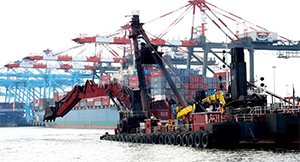New legislation proposed in Congress would eliminate the appropriations bottleneck affecting the Harbor Maintenance Trust Fund, taking it “off budget” to ensure the nation’s ports are properly maintained.
Currently, Congress must make appropriations in each budget cycle to the Army Corps of Engineers from the trust fund to maintain and operate port infrastructure. The bill, introduced in April by Rep. Mike Kelly, R-Pa., and Rep. Peter DeFazio, D-Ore., would change the process and set up automatic appropriations based on the tax revenue collected.
The Harbor Maintenance Tax is an excise tax collected from shippers specifically to maintain harbors and ports. Currently the tax generates about $1.7 billion annually, but Congress has restricted spending on harbor maintenance due to budgetary constraints, resulting in “crumbling infrastructure and harbors choked with sand and silt.”
The tax was created as part of the Water Resources Development Act of 1986 and was levied upon shippers for port use associated with imports, exports and the movement of cargo and passengers between U.S. ports. In 1998, the Supreme Court ruled that taxing export products was unconstitutional.
Today, the Harbor Maintenance Tax is assessed on cargo transported between any two U.S. coastal ports, including Great Lakes ports, and cargo imported to U.S. ports from other countries. The tax is assessed on the value of commercial cargo or cruise tickets sold, at a rate of 0.125 percent of the value of the cargo. The tax is not collected on shipments through inland river ports; instead, commercial barge operators pay a federal fuel tax.
The tax revenue flows into the Harbor Maintenance Trust Fund, which Congress appropriates for qualified activities such as dredging channels, maintaining jetties and breakwaters, and operating locks along the coasts and in the Great Lakes.
Tax revenues are determined by the level of trade, which has grown in recent years. Currently there is a $9 billion surplus in the Harbor Maintenance Trust Fund, although it is technically a part of the government’s general funds.
According to the American Great Lakes Port Association, enacting the bill would boost the Corps’ coastal operation and maintenance program from approximately $1.3 billion a year to $1.8 billion a year.
“Based on current estimates, this level of spending should be sufficient to restore all harbor channels to their constructed dimensions,” said Jim Walker, director of navigation policy and legislation for the American Association of Port Authorities.
Steve Fisher, executive director of the American Great Lakes Ports Association, said the maintenance backlog for the Great Lakes alone includes $200 million of dredging work, $250 million to rehabilitate breakwaters and jetties, and $115 million to rehabilitate the Soo Locks.
Since 2014, Congress has followed a schedule to increase funding for harbor maintenance and dredging to reach 100 percent utilization of the funds by 2025. If the bill proceeds, it’s likely to become part of larger appropriations or infrastructure legislation, Walker said.
“The ultimate solution is to have the funding go directly to the Corps of Engineers for maintenance and operations,” he said.
However, political challenges include pressure from Congress to control spending as the surplus in the fund helps offset budget deficits.
Also, the House Appropriations Committee is reluctant to allow spending to bypass the budget process, fearing demands from other sectors for similar treatment that could take authority away from Congress, Walker noted.
The Trump administration has made infrastructure investment a top priority, and the industry cites harbor maintenance as a prime target.
“Currently, the tax generates sufficient funds to maintain the waterways if it were fully funded, so there’s no need for new taxes,” Walker said. “Congress just has to spend the money that’s already been collected.”

